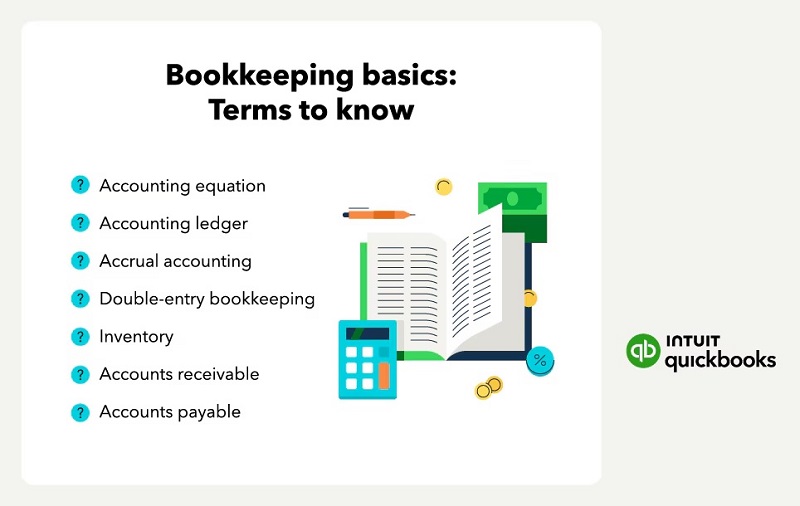
Empowering Your Small Business: The Value of Consistent Accounting
May 6, 2024
Stop Losing Money! The Accounting Skills Every Business Owner Needs (Right Now)
May 26, 2024Part 1: Understanding Bookkeeping Fundamentals
Bookkeeping is the foundation of any healthy business. It’s the process of recording, classifying, summarizing, and reporting your financial transactions. By keeping meticulous bookkeeping records, you gain a clear understanding of your business’s financial health, allowing you to make informed decisions about your operations and future.
This guide dives into the essential concepts of bookkeeping, equipping you with the knowledge to manage your business finances effectively.
What is Bookkeeping?
Bookkeeping is the systematic recording of a business’s financial transactions. It involves capturing every financial exchange, from sales and purchases to expenses and payroll. This data is then organized and categorized for easy analysis and reporting.
Why is Bookkeeping Important?
- Financial Clarity: Bookkeeping provides a clear picture of your business’s financial health. You can see how much money is coming in (revenue), how much is going out (expenses), and what assets and liabilities you have.
- Informed Decision-Making: With accurate financial data, you can make informed business decisions about pricing, staffing, inventory management, and future investments.
- Tax Preparation: Bookkeeping records are crucial for filing accurate tax returns. Having your finances organized saves time and money during tax season.
- Improved Cash Flow Management: Bookkeeping helps you track your cash flow, allowing you to predict future financial needs and avoid cash shortages.
Bookkeeping vs. Accounting
While bookkeeping focuses on the day-to-day recording of financial transactions, accounting involves analyzing and interpreting this data to create financial statements and reports. Accountants use the information gathered by bookkeepers to provide insights into the financial performance and health of a business.
The Accounting Equation
The foundation of all bookkeeping lies in the accounting equation:
Assets = Liabilities + Equity
- Assets: These are the resources your business owns, such as cash, inventory, equipment, and property.
- Liabilities: These are the debts your business owes, such as accounts payable, loans, and taxes.
- Equity: This represents the owner’s investment in the business, including any profits retained.
This equation must always remain balanced. Every transaction will affect at least two accounts in the equation, ensuring the total assets always equal the sum of liabilities and equity.
Understanding Accounts:
- Assets, liabilities, and equity are further categorized into specific accounts within your chart of accounts. This organized system allows for detailed tracking of all financial activity.
Examples of Accounts:
- Assets: Cash, Accounts Receivable, Inventory, Equipment, Buildings
- Liabilities: Accounts Payable, Loans Payable, Taxes Payable
- Equity: Owner’s Capital, Retained Earnings
The Bookkeeping Cycle
The bookkeeping cycle is a continuous process that ensures accurate financial records. It involves the following steps:
- Transaction Identification and Recording: Every financial transaction must be identified and recorded in your accounting system. This includes the date, amount, and a brief description.
- Classification: Each transaction is categorized according to the appropriate account in your chart of accounts.
- Summarization: Periodically, the information from your transactions is summarized into your general ledger, which is a historical record of all financial activity.
- Reporting: Financial statements, such as the income statement and balance sheet, are generated from the summarized data in the general ledger. These reports provide valuable insights into your business’s financial performance.
Bookkeeping Methods
There are two primary bookkeeping methods used by businesses:
- Single-Entry Bookkeeping:
This is a simpler method that focuses on recording only the financial inflow (revenue) and outflow (expenses) of a business. It does not utilize the accounting equation and relies on bank statements and receipts for tracking finances.
-
Advantages:
- Easy to set up and maintain.
- Suitable for small businesses with limited transactions.
- Low cost compared to double-entry bookkeeping.
-
Disadvantages:
- Limited financial information.
- Doesn’t provide a clear picture of your financial health.
- Makes it difficult to detect errors.
- Not recommended for businesses with complex transactions or inventory management.
-
Double-Entry Bookkeeping:
This is the most widely used bookkeeping method. It involves recording every transaction twice, affecting two accounts in the accounting equation to maintain balance. This creates a more detailed and accurate picture of your finances.
-
Advantages:
- Provides a more complete picture of your financial health.
- Easier to detect errors through balancing entries.
- Generates valuable financial reports for analysis and decision-making.
- Required by most tax authorities for accurate tax filing.
-
Disadvantages:
- More complex to set up and maintain compared to single-entry.
- Requires a deeper understanding of accounting principles.
- Can be time-consuming for businesses with high transaction volume.
Choosing the Right Bookkeeping Method
The right bookkeeping method depends on the size and complexity of your business.
Here are some factors to consider:
- Transaction Volume: If your business has a low number of transactions, single-entry bookkeeping might suffice. However, double-entry is recommended for businesses with higher volume.
- Financial Reporting Needs: Double-entry bookkeeping provides more detailed financial data for generating reports and analyzing your business performance.
- Accounting Expertise: Single-entry bookkeeping is easier to manage, but double-entry requires a deeper understanding of accounting principles.

Chart of Accounts
The chart of accounts is the foundation of your bookkeeping system. It’s a list of all the accounts you will use to categorize your financial transactions. These accounts fall into various categories based on the accounting equation:
- Assets Accounts: Represent the resources owned by your business. (e.g., Cash, Accounts Receivable, Inventory, Equipment)
- Liabilities Accounts: Represent the debts owed by your business. (e.g., Accounts Payable, Loans Payable, Taxes Payable)
- Equity Accounts: Represent the owner’s investment and retained earnings. (e.g., Owner’s Capital, Retained Earnings)
- Revenue Accounts: Represent the income generated by your business. (e.g., Sales Revenue, Service Revenue)
- Expense Accounts: Represent the costs incurred by your business. (e.g., Rent Expense, Salary Expense, Marketing Expense)
Setting up a well-organized chart of accounts is crucial for accurate and efficient bookkeeping. It allows you to easily track specific categories of income and expenses, providing valuable insights into your financial activity.
Recording Transactions
Accurately recording your business transactions is essential for maintaining reliable financial records. Every financial exchange, no matter how small, needs to be captured in your bookkeeping system.
Why Accurate Transaction Recording Matters
Accurate recording ensures your financial reports and statements are reliable, reflecting the true financial health of your business. This helps you make informed financial decisions and avoid errors during tax filing.
Types of Business Transactions
- Sales Transactions: This includes revenue generated from selling products or services to customers. You would record the sale amount in a revenue account and the corresponding cost of goods sold in an expense account.
- Purchase Transactions: This refers to any goods or services your business purchases for its operations. You would record the purchase amount in an expense account and the payment method used (cash, credit) in the appropriate account.
- Payroll Transactions: This involves recording employee salaries, wages, and taxes withheld. You would debit payroll expense accounts and credit liabilities accounts like salaries payable.
- Payment Transactions: This includes any payments made by your business, such as rent, utilities, or loan payments. You would debit the expense account for the payment and credit the cash account used for the payment.
Documentation for Bookkeeping
It’s crucial to maintain proper documentation for all your transactions. This includes invoices, receipts, canceled checks, and bank statements. These documents serve as evidence of your financial activity and can be helpful for audits or tax purposes.
Bank Reconciliation
Bank reconciliation is the process of comparing your bank account records with your bookkeeping records to ensure they match. Discrepancies can occur due to outstanding checks, deposits in transit, or bank fees.
Why Bank Reconciliation is Important
Regular bank reconciliation helps identify errors in your bookkeeping and ensures the accuracy of your financial records. It also helps you detect any fraudulent activity on your business bank account.
Steps in Bank Reconciliation
- Gather Statements: Obtain your most recent bank statement and reconcile it with your bookkeeping records.
- Compare Balances: Match the ending balance on your bank statement with the ending balance in your cash account.
- Identify Differences: Investigate any discrepancies between the two balances. This could involve outstanding checks, deposits in transit, or bank fees.
- Adjust Records: Make necessary adjustments to your bookkeeping records to reflect the actual bank balance.
- Reconcile the Difference: Once adjustments are made, the reconciled balance should match the ending balance on your bank statement.
By performing regular bank reconciliations, you can maintain accurate financial records and ensure the integrity of your bookkeeping system.

Part 2: Putting Bookkeeping into Practice
Now that you have a grasp of bookkeeping fundamentals, let’s explore how to implement these concepts into your daily business operations.
Bookkeeping Tasks and Responsibilities
Effective bookkeeping involves a variety of tasks and responsibilities:
-
Common Bookkeeping Tasks:
- Data Entry: Recording financial transactions into your accounting system, including sales, purchases, payroll, and payments.
- Categorizing Transactions: Classifying each transaction according to the appropriate account in your chart of accounts.
- Reconciling Accounts: Regularly comparing your bank statements with your bookkeeping records to ensure accuracy.
- Generating Reports: Creating financial reports like income statements, balance sheets, and cash flow statements to analyze your business performance.
-
Bookkeeper vs. Accounting Software:
While some businesses choose to hire a dedicated bookkeeper, bookkeeping software can be a cost-effective alternative for many small businesses. Accounting software automates many tedious bookkeeping tasks, saving you time and minimizing errors.
Accounting Software for Bookkeeping
Accounting software offers a multitude of benefits for managing your business finances:
-
Benefits of Using Accounting Software:
- Streamlines data entry: Simplifies recording and categorizing transactions.
- Automates tasks: Saves time by automating repetitive tasks like bank reconciliation and report generation.
- Improves accuracy: Reduces the risk of errors with automated calculations and data validation features.
- Provides real-time insights: Offers up-to-date financial data for informed decision-making.
- Secure cloud storage: Ensures safe and accessible storage of your financial records.
-
Popular Accounting Software Options: There are numerous accounting software options available, each catering to different business needs and budgets. Some popular choices include QuickBooks, Xero, FreshBooks, and Zoho Books.
-
Selecting the Right Accounting Software: Consider factors like your business size, transaction volume, budget, and desired features when choosing accounting software.
Internal Controls for Bookkeeping
Implementing strong internal controls is essential for safeguarding your business finances and ensuring the accuracy of your bookkeeping records.
- The Importance of Internal Controls:
Internal controls help prevent errors and fraud, protecting your business assets and maintaining the integrity of your financial data.
- Examples of Internal Controls:
Here are some internal control measures you can implement:
- Segregation of Duties: Divide bookkeeping tasks among different employees to minimize the risk of errors or fraud.
- Safeguarding Assets: Secure physical assets like cash and inventory, and restrict access to sensitive financial information.
- Accurate Recordkeeping: Maintain accurate and up-to-date bookkeeping records, including proper documentation for all transactions.
- Regular Reviews: Conduct regular reviews of your bookkeeping system and internal controls to identify any weaknesses.
- By establishing strong internal controls, you can build trust in your financial data and make informed decisions based on reliable information.
Financial Statements for Small Businesses
Financial statements are the culmination of your bookkeeping efforts. These reports provide a comprehensive overview of your business’s financial health and performance.
- What are Financial Statements?
Financial statements are formal reports that summarize your business’s financial activity and position. They are essential for analyzing your business performance, securing funding, and meeting tax filing requirements.
- Types of Financial Statements:
The three main financial statements used by small businesses are:
- Income Statement (Profit and Loss Statement): Summarizes your business’s revenue and expenses over a specific period, showing your net profit or loss.
- Balance Sheet: Provides a snapshot of your business’s financial position at a specific point in time, listing your assets, liabilities, and equity.
- Cash Flow Statement: Shows the movement of cash in and out of your business, categorized by operating, investing, and financing activities.
- Importance of Financial Statements for Businesses:
Financial statements offer valuable insights into your business’s profitability, liquidity, and solvency. They can be used to:
- Track performance: Monitor your business’s financial progress over time and identify areas for improvement.
- Make informed decisions: Use financial data to guide your business strategies and investments.
- Secure funding: Financial statements are essential for obtaining loans or attracting investors.
- Meet tax requirements: Accurate financial statements are crucial for filing your business taxes.
By understanding and utilizing financial statements, you gain a deeper understanding of your business’s financial health and can make informed decisions to drive success.
FAQs
This section addresses some of the most common questions regarding bookkeeping for small businesses:
- Q: Do I need a bookkeeper for my small business?
A: The decision to hire a bookkeeper depends on the complexity of your business finances and your own comfort level with bookkeeping tasks. For businesses with a high volume of transactions or complex accounting needs, hiring a qualified bookkeeper can be a wise investment. However, bookkeeping software can be a suitable option for many small businesses, especially those starting out.
- Q: How much does bookkeeping cost?
A: The cost of bookkeeping varies depending on the experience of the bookkeeper, the size and complexity of your business, and the services required. Bookkeepers typically charge an hourly rate or a monthly retainer. Accounting software can range from free basic plans to robust paid subscriptions with advanced features.
- Q: What are the benefits of outsourcing bookkeeping?
A: Outsourcing bookkeeping offers several advantages:
- Saves time: Allows you to focus on core business activities while a professional handles the bookkeeping tasks.
- Improves accuracy: Qualified bookkeepers can minimize errors and ensure compliance with accounting regulations.
- Provides expertise: Gain access to the knowledge and experience of a bookkeeping professional.
- Enhanced financial insights: Bookkeepers can assist you in interpreting financial data and generating valuable reports.
- Q: Can I learn bookkeeping on my own?
A: Absolutely! Numerous online resources and courses are available to teach you the fundamentals of bookkeeping. Accounting software often comes with built-in tutorials and support resources. However, if your business grows or your finances become more complex, consider seeking professional assistance from a bookkeeper or accountant.
- Q: What are some common bookkeeping mistakes?
A: Here are some common bookkeeping mistakes to avoid:
- Inaccurate or incomplete data entry: Double-check all transactions for accuracy and ensure all relevant information is captured.
- Not using a chart of accounts: A well-organized chart of accounts is crucial for categorizing transactions effectively.
- Neglecting bank reconciliation: Regularly reconcile your bank statements to identify and rectify errors.
- Poor recordkeeping: Maintain proper documentation for all financial transactions.
- DIY bookkeeping for a complex business: Don’t hesitate to seek professional help if your bookkeeping needs become too demanding.
By understanding these common pitfalls and implementing best practices, you can ensure your bookkeeping system is accurate, efficient, and provides valuable insights for your small business.
Resources
- Small Business and Self-Employed Tax Center provides valuable resources.
Service Corps of Retired Executives (SCORE)
- Small Business Bookkeeping. A non-profit resource partner of the SBA, offers a helpful article on 10 Bookkeeping Basics You Can’t Ignore.
Small Business Administration (SBA)
- Business Basics
DISCLAIMER: The information in this article is for informational purposes only and is not meant to take the place of legal and accounting advice.




